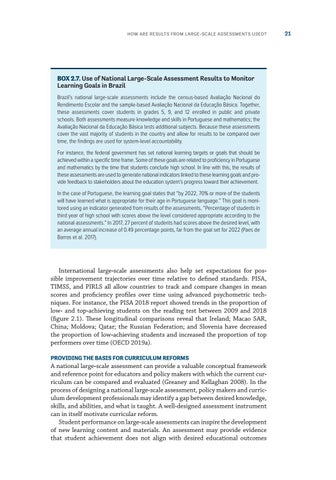How Are Results from Large-Scale Assessments Used?
BOX 2.7. Use of National Large-Scale Assessment Results to Monitor Learning Goals in Brazil Brazil’s national large-scale assessments include the census-based Avaliação Nacional do Rendimento Escolar and the sample-based Avaliação Nacional da Educação Básica. Together, these assessments cover students in grades 5, 9, and 12 enrolled in public and private schools. Both assessments measure knowledge and skills in Portuguese and mathematics; the Avaliação Nacional da Educação Básica tests additional subjects. Because these assessments cover the vast majority of students in the country and allow for results to be compared over time, the findings are used for system-level accountability. For instance, the federal government has set national learning targets or goals that should be achieved within a specific time frame. Some of these goals are related to proficiency in Portuguese and mathematics by the time that students conclude high school. In line with this, the results of these assessments are used to generate national indicators linked to these learning goals and provide feedback to stakeholders about the education system’s progress toward their achievement. In the case of Portuguese, the learning goal states that “by 2022, 70% or more of the students will have learned what is appropriate for their age in Portuguese language.” This goal is monitored using an indicator generated from results of the assessments, “Percentage of students in third year of high school with scores above the level considered appropriate according to the national assessments.” In 2017, 27 percent of students had scores above the desired level, with an average annual increase of 0.49 percentage points, far from the goal set for 2022 (Paes de Barros et al. 2017).
International large-scale assessments also help set expectations for possible improvement trajectories over time relative to defined standards. PISA, TIMSS, and PIRLS all allow countries to track and compare changes in mean scores and proficiency profiles over time using advanced psychometric techniques. For instance, the PISA 2018 report showed trends in the proportion of low- and top-achieving students on the reading test between 2009 and 2018 (figure 2.1). These longitudinal comparisons reveal that Ireland; Macao SAR, China; Moldova; Qatar; the Russian Federation; and Slovenia have decreased the proportion of low-achieving students and increased the proportion of top performers over time (OECD 2019a). PROVIDING THE BASIS FOR CURRICULUM REFORMS
A national large-scale assessment can provide a valuable conceptual framework and reference point for educators and policy makers with which the current curriculum can be compared and evaluated (Greaney and Kellaghan 2008). In the process of designing a national large-scale assessment, policy makers and curriculum development professionals may identify a gap between desired knowledge, skills, and abilities, and what is taught. A well-designed assessment instrument can in itself motivate curricular reform. Student performance on large-scale assessments can inspire the development of new learning content and materials. An assessment may provide evidence that student achievement does not align with desired educational outcomes
21

